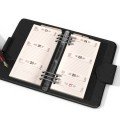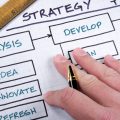Begin With The End In Mind
Do you wonder how some people seemingly rack up win after win, complete project after project, apparently unswayed by detail and interruption?
Have you watched these people achieve goal after goal exactly as they set out to do and wondered what their secret was?
It’s because they set out with a very clear objective, and vision of what the end looks like. Stephen Covey (The 7 Habits of Highly Effective People) called it his second habit “Begin with the end in mind.”
If you have a very clear picture of what the end should look like, it resolves so many problems along the way. If you know exactly what you want at the end, the answers to questions about detail like “who should be involved,” or “who do we hire out of these choices,” or “which option is the best” all become clear because you know exactly who you need in your team to put it together because of the skills you need; what type of person to hire to best suit the way it is to be managed at the end; and which option – despite the cost – best meets your objectives most efficiently.
A vision of the end not only sets the goals, but because you are so clear on what it looks like, also establishes the correct process of getting there, because anything that doesn’t or isn’t likely to get you to exactly the right place is out.
I have 5 steps anyone can take to make sure that they begin with the end in mind.
Take these 5 steps, and every time, you will start your task with a razor like focus on getting the result you want.
Watch this video to get you through the 5 steps.
So there you are, a simple set of steps to take each time you start a project. It also works in building the high level strategic picture of your business – your ultimate vision statement of where you want your business to go.
Let’s go through the 5 steps again.
First before you start a project, a task, a plan, a day, ask “what exactly do I want when I finish?” Ask yourself what it will look like when finished; what problems will it have solved; what will it take in time, people, money and resources? Describe the end result in as great detail as possible then ask yourself how you will feel when it is finished? How will you feel about the way it finally works? This will help you to ask the final question in describing the end – how will you recognise when you have got there?
After you have a very clear picture of the end and how it all works and solves your problem, the second step is to take the time to ask “what will it take to get there?”
This is about the process of getting to the end, rather than a picture of how the end actually “operates.” So, explore questions like how much time will it take, and what the stages are likely to be to get to that ultimate picture? What tools or other resources or people are you going to need to build the solution? What kind of preparation will you need to have these resources available and in the right order? What about any rules on how the process takes place, do you need to write a set of procedures or a workflow?
The third step is to work out how you will measure success. In the first step you asked yourself “how will I recognise when I’ve got to my desired end result?” The answers may have been something about quantity (“I’ll have got to my vision when my sales are X dollars”) or process (“At the end, the reporting process will only take 2 hours”) or quality (“I’ll know when I’ve got to the end because people will praise the improvement of service”).
In the third step, you define the actual number, or process gain, or quality that will mean the task is completed in accordance with your vision of it. In this step you may also want to break the project into milestones and measure at each milestone. For example, “after we have completed our marketing launch, our sales will grow to $500,000, then after we implement our after-care service follow up calls, sales will grow to $700,000.”
The fourth step is to put together the plan.
Your vision, or the “end in mind” is only a target. Having a plan makes it achievable.
Map out the steps you have to take, when, what tools and resources you need at each step, and what the milestones are going to be. Make sure your plan is written down, even if (assuming it’s a small task like doing the ironing!) it’s only a checklist to be done in the right order.
Then, just do it! The fifth step is to immediately do the first action, then the next, and so on, and build momentum, all the time keeping a clear focus on the end in mind.
So there’s your 5 steps:-
- Begin with a clear vision of the end;
- Clarify what you need to get there;
- Define your measures of “success;”
- Put your plan on paper; and
- Take the first action.
Here’s where the fun starts! Put in a comment below or email me and tell me how you’ve been able to put this into practice.
If you want to know more about how you can build a great business – despite the lack of time and the stack of things on your desk – join me to find out about systems, step by step procedures, plans and templates that you can use.
If you saw this article in one of my social media posts – go to teikoh.com to view all the other tips, tools, resources and processes to start your business, grow it, and build it into the business that’s in your vision. Make sure you sign up with your name and email in order to get valuable business ideas sent directly to your inbox every week!






No comments yet.
Add your comment